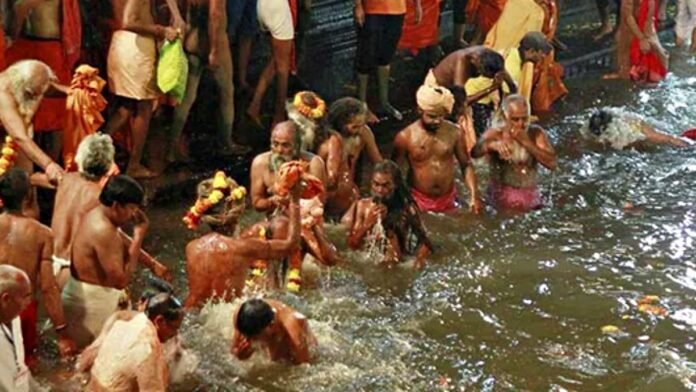
Key Points:
- Water at the Sangam in Prayagraj fails to meet primary bathing standards due to high levels of faecal coliform.
- CPCB report reveals contamination exceeding permissible limits, posing health risks for millions of devotees.
- NGT directs urgent measures to improve water quality; UPPCB criticized for non-compliance with earlier directives.
- Authorities intensify cleaning efforts, including trash skimmers, sewage treatment, and fresh water releases.
Prayagraj: The ongoing Maha Kumbh Mela in Prayagraj, one of the largest religious gatherings in the world, has been overshadowed by alarming reports of water contamination at the confluence of the Ganga and Yamuna rivers. The Central Pollution Control Board (CPCB) informed the National Green Tribunal (NGT) on Monday (February 17) that water quality at the Sangam is failing to meet primary standards for bathing due to dangerously high levels of faecal coliform bacteria.
A CPCB report dated February 3 revealed that faecal coliform levels at all monitored locations exceeded the permissible limit of 2,500 units per 100 ml, indicating severe sewage contamination. This is particularly concerning as millions of devotees have been taking ritual baths during the ongoing 45-day festival, especially on auspicious days like Mauni Amavasya and Basant Panchami.
NGT Criticizes Authorities for Lapses
The findings were reviewed by an NGT bench comprising Chairperson Justice Prakash Shrivastava, Judicial Member Justice Sudhir Agarwal, and Expert Member A Senthil Vel. The tribunal expressed concern over the Uttar Pradesh Pollution Control Board’s (UPPCB) failure to submit a comprehensive action plan despite earlier directives. Instead, the UPPCB provided only partial test results confirming high contamination levels.
The NGT has summoned the Member Secretary of UPPCB and other state officials to appear virtually on February 19 to explain their lapses. It also granted one day for the Uttar Pradesh government’s counsel to respond to the CPCB report.
Health Risks and Environmental Concerns
The high levels of faecal coliform indicate contamination from untreated sewage and animal waste, raising significant public health concerns. Experts warn that exposure to such polluted water could lead to outbreaks of waterborne diseases such as cholera, typhoid, and dysentery among devotees.
Additionally, elevated Biological Oxygen Demand (BOD) levels measured at 4 mg per liter on January 14 against a standard limit of 3 mg per liter highlight excessive organic matter in the water. This threatens aquatic life and disrupts the river ecosystem.
Cleaning Efforts Intensified
In response to these alarming findings, authorities have launched extensive measures to improve water quality:
- Trash Skimmers: Two machines are deployed along a 4-km stretch near the Sangam to remove floating waste daily. Each machine extracts 10-15 tonnes of waste, including plastic, floral offerings, and other debris.
- Sewage Treatment Plants (STPs): Temporary STPs have been set up to intercept untreated sewage from 34 drains before it reaches the rivers.
- Fresh Water Releases: Over 6,000 cusecs of fresh water are being released from Narora Dam into the Ganga to dilute pollutants.
- Dedicated Volunteers: “Ganga Sevadoots” are stationed at ghats to collect ritual waste every two hours and ensure cleanliness.
- Daily Monitoring: Pollution Control Board officials are conducting daily water quality tests at multiple locations.
Challenges in Managing Mass Gatherings
With over 54 crore devotees expected to visit the Maha Kumbh by February 26, managing pollution remains a colossal challenge. On peak bathing days like Mauni Amavasya, nearly 50 lakh people took a dip at the Sangam. Authorities estimate that these visitors generate approximately 16 million liters of fecal sludge and 240 million liters of greywater daily.
Despite efforts like deploying advanced waste management technologies from ISRO and BARC, including hybrid granular sequencing batch reactors (hgSBR), challenges persist due to the sheer scale of human activity.
Broader Implications for River Health
This crisis underscores long-standing issues with river pollution in India. Despite massive investments under programs like Namami Gange over ₹40,000 crore spent since its launch in 2014 large stretches of the Ganga remain polluted due to untreated sewage, industrial effluents, and agricultural runoff.
Environmentalists argue that while festivals like Kumbh Mela celebrate India’s cultural heritage, they also strain fragile ecosystems. The ongoing contamination raises questions about whether religious events can coexist with sustainable environmental practices.
Looking Ahead: A Call for Accountability
As millions continue to gather for spiritual cleansing at Maha Kumbh 2025, ensuring safe water quality remains an urgent priority. The NGT’s intervention highlights systemic failures in managing pollution but also offers hope for accountability.
With just days left until the festival concludes on February 26, authorities face mounting pressure to deliver tangible improvements in water quality while safeguarding public health and preserving India’s sacred rivers for future generations.



















































